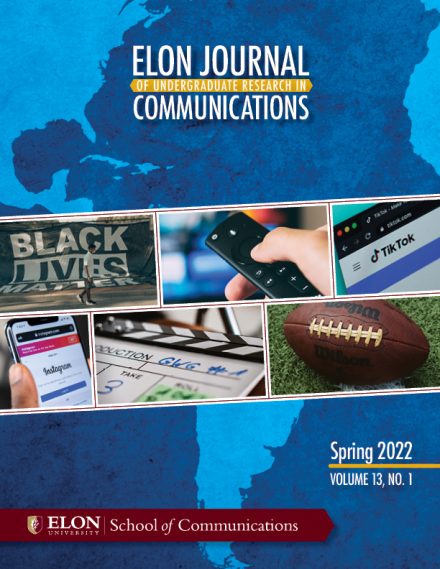In the spring 2022 issue of the Elon Journal, six student researchers delve into a variety of media-related topics, including the media framing of mass shooters and whether the portrayal of these perpetrators changed after the 2020 Black Lives Matter protests.
The School of Communications has published the spring 2022 issue of the Elon Journal of Undergraduate Research in Communications, featuring student research on topics ranging from Instagram’s role enabling toxic, parasocial relationships between athletes and fans to the representation of marginalized identities in predominately white TV shows.

The issue contains six research papers authored by School of Communications students, including a topical examination of online news coverage of Black and white mass shooters, and whether the portrayal of these perpetrators changed after the 2020 Black Lives Matter protests.
Michaela VanDerVelden conducted the aforementioned research, completing a qualitative content analysis of 36 articles regarding mass shootings. Her findings suggest that articles about Black perpetrators were less likely to include mental health discussions. Additionally, VanDerVelden found that the articles were more likely to include behavioral details about the shooter that were irrelevant to the crime.
In his From the Editor letter, Professor Harlen Makemson noted that for decades bloggers and citizen journalists have been shaping public discourse and upending the old media order. “In the era of social media, the phenomenon of users creating meaning has only mushroomed, as the spring 2022 edition of the Elon Journal demonstrates,” he wrote.
For example, Olivia Archer’s published research examines how Instagram facilitates parasocial relationships between fans and professional athletes, with sometimes distressing outcomes. Archer conducted a quantitative analysis to learn how fans of professional tennis players Naomi Osaka and Eugenie Bouchard engaged with online content. Likewise, Madeline Distenfeld investigated how TikTok users have shaped debates around fast fashion and sustainable fashion.
While focused on audience perceptions and not social media, Jeremy Palladino investigated how fictional characters with symptoms of aphasia, a mental disorder causing difficulty with speech production or language comprehension, are portrayed in scripted film and television. As part of a semi-structured focus group, a college-aged audience assessed three characters (Hodor from “Game of Thrones,” Timmy from “South Park,” and Michael Armstrong from “Hot Fuzz”) and discussed their initial reactions of characters displaying aphasia.
Legacy media’s portrayals of constituent groups in society was also addressed in the most-recent journal issue. Matisse Gilmore used quantitative methodology to explore the appearance of marginalized identities in primetime television sitcoms, and her findings indicate there has been growth in representation. Additionally, Emily Holland performed a content analysis of women’s appearances in Super Bowl commercials, a largely unexamined area in recent years.
For this spring 2022 issue, Makemson assembled an editorial board of more than 20 communications faculty members who participated in the multiple blind-review process to select the best student work.
The Elon Journal began in spring 2010, with spring and fall editions each year. The spring 2022 journal marks the 25th edition.
The Council on Undergraduate Research catalogs more than 200 student research journals in the nation, and the Elon Journal is one of the few that focuses on undergraduate student research in journalism, media and communications.


